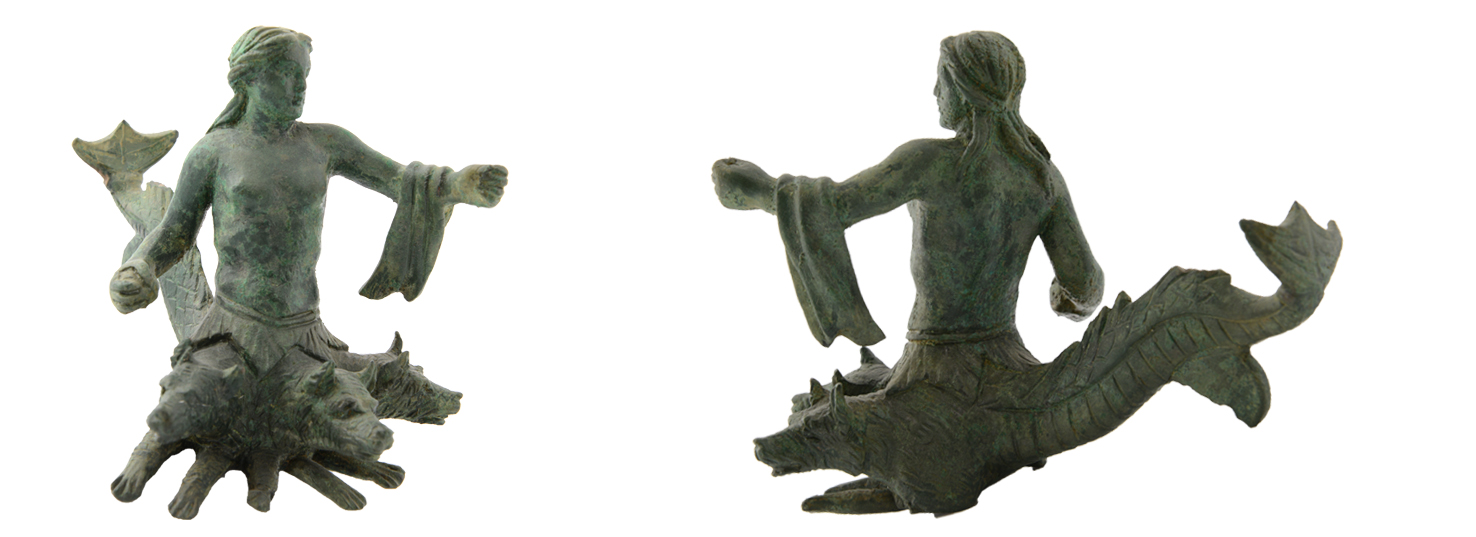Exhibit of the month
Aquatic dreads …
Figurine of Scylla
National Archaeological Museum
Collection of Bronze Metalwork, inv. no X21084
Provenance: Kataphylli in Karditsa, area of Argithea
Dimensions: Height: 0.09 m, Length: 0.114 m
Date: late 4th c. BC
Display location: Bronze Metalwork Collection, Room 36, Showcase 11.
The bronze hybrid with the body of a woman, dog heads sprouting from her waist and a fish tail depicts Scylla, one of the sea monsters which Odysseus encountered after he left Circe’s island. The hero initially passed the island of the Sirens, the mythical creatures with the body of a bird and the head of a woman. Whoever listened to their enchanting song was unable to remember his family and homeland and died there. Tied to the ship’s mast and having plugged the ears of his comrades with wax first, Odysseus escaped the Sirens to confront Scylla and Charybdis soon afterwards. According to the Homeric description, Scylla had twelve legs and six long necks ending in an equal number of heads with two triple rows of teeth.
Her cavern was situated in the Strait of Messina in Sicily or, according to a different view, at the Strait of Bosporus. Opposite her, lived the ferocious Charybdis who sucked and spewed the waters of the sea forming a whirlpool in which ships sunk. Following Circe’s advice, Odysseus managed to avoid Charybdis, losing six of his companions to Scylla. Heracles, upon his return after stealing the cattle of Geryon having accomplished his tenth Labour, killed and dismembered Scylla for she had devoured one of the oxen. His father Phorcys, son of Pontus and Gaea, a primordial god of the sea prior to Poseidon, restored her to life.
In the Greek art the Homeric Scylla is humanized being transformed into a gracious sea demon depicted as a female figure. In her early representations she is shown clothed, but from the late 5th c. BC onwards her nudity is established underscoring her marine nature and erotic element. The murderous Scylla later appears in iconography hurling a rock or grabbing Odysseus’ comrades from his ship.
The bronze figurine depicts Scylla holding a stone in her right hand threatening an imaginary rival whom she possibly repels with the rudder or the oar which she most likely held in her left hand. Despite the violent movement the carefully combed long hair and the short himation, an unnatural element for a creature of the sea, reflect earlier tranquil representations of the demon. The integral small disc under the curved tail indicates that the figurine served as an attachment to an incense burner or vase. The second bronze Scylla of the National Archaeological Museum depicted on a decorative plaque is portrayed serene holding an oar or a rudder.
Aside from being symbol of the sea, the presence of Scylla in funerary monuments, rendered either in relief or carved in the round, is associated with her chthonic nature as a demon of death that accompanies the soul of the deceased to the Isles of the Blessed. Connected with Hades, as Muses of the Underworld, are also the Sirens, offspring of the same sea god, which are often depicted in funerary monuments.
Apart from Scylla and the Sirens, three Gorgons are also Phorcides, namely daughters of Phorcys, Stheno, Euryale and the fierce Medusa, winged hybrids with the body of a woman, hair made of serpents and teeth that resembled the tusks of a wild boar. Medusa lived in the West, beyond Oceanus, at the ends of the world and anyone who encountered her turned instantly into stone. Associated with the myth of Gorgon Medusa is the Argive hero Perseus who decapitated her and escaped the chase by her brothers assisted by Athena. Since then Medusa’s head adorns the aegis of the goddess turning her untouchable.
Scylla, Charybdis, the Sirens and the Gorgons symbolize the voyage and the sea and incarnate the human fear for unknown realms. The victory of Heracles and Perseus or versatile Odysseus marks the age of reason and knowledge against myth and the fictitious.
Dr Calliope Bairami
Bibliography:
Ε. Βλαχογιάννη, Το αγαλμάτιο Σκύλλας 3913 του Εθνικού Αρχαιολογικού Μουσείου. Εικονογραφικές παρατηρήσεις, Το Μουσείον 6, 2006-2008, 15-28, κυρίως 23, n. 63.
Ν. Καλτσάς, Εθνικό Αρχαιολογικό Μουσείο. Τα Γλυπτά, Αθήνα 2002, 280, cat. no 586.
LIMC, Suppl. I, 2009, s.v. Σκύλλα Ι, 455, no add. 15 (Ν. Ιcard-Gianolio – A.V. Szabados).
General bibliography
RE XX 1, λ. Phorkys, ll. 534-535 (J. Schmidt), Stuttgart 1941.
Ι.Θ. Κακριδή (ed.), Ελληνική Μυθολογία, Αθήνα 1986.
LIMC VIII, 1997, s.v. Σκύλλα Ι, 1137-1145 (Μ.-Ο. Jentel).
E. Walter-Karydi, Dangerous is Beautiful. The Elemental Quality of a Hellenistic Skylla, στο Ο. Palagia – W. Coulson (eds), Regional Schools in Hellenistic sculpture, Proceedings of an International Conference held at the American School of Classical Studies at Athens, March 15-17, 1996, Oxford 1998, 271-279.


